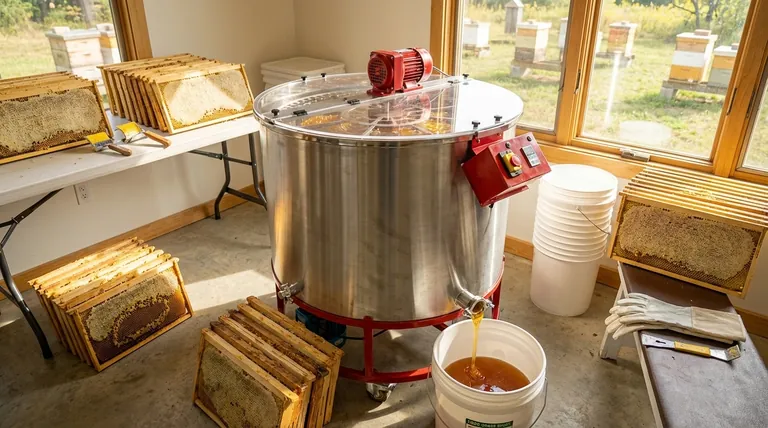At their core, electric honey extractors offer three transformative advantages over manual models: they are significantly faster, require far less physical labor, and can process a much higher volume of frames at once. This combination dramatically increases the efficiency of your honey harvest, especially as your beekeeping operation grows.
The decision to upgrade to an electric extractor is not just about convenience; it's a strategic choice about scale. While manual extractors are sufficient for a few hives, electric models are a near necessity for any beekeeper looking to manage a larger apiary efficiently and profitably.

The Core Advantages: Speed and Scale
The most immediate benefits you will notice after switching to an electric extractor revolve around pure operational efficiency. They are designed to minimize time and effort during the most labor-intensive part of the harvest.
Drastically Reduced Extraction Time
An electric motor spins frames much faster and more consistently than is possible by hand. This allows you to process a large number of frames in a fraction of the time, turning a multi-day task into a single day's work.
Significantly Less Physical Labor
Motorized extraction completely eliminates the strenuous, repetitive work of manual cranking. This benefit is invaluable for beekeepers with many hives or anyone with physical limitations, reducing fatigue and the risk of strain.
Higher Frame Capacity
Electric extractors are built for volume. While small models exist, many are designed to hold dozens of frames—with some commercial units handling up to 100 at a time. This capacity is essential for large-scale and commercial beekeepers.
Advanced Control and Consistency
Beyond raw power, electric models offer a level of precision that protects your equipment and improves your final product.
The Power of Variable Speed Control
Many electric extractors feature variable speed control. This allows you to start the spin slowly to extract honey from delicate new comb without destroying it, then ramp up the speed to efficiently clear heavier, older comb.
Consistent Results, Less Comb Damage
The controlled, consistent spinning force of a motor is much gentler on frames than the jerky, uneven force of hand-cranking. This precision leads to less broken comb, which saves the bees significant time and energy rebuilding it later.
Uninterrupted Monitoring
Because you are not occupied with cranking, you can more easily monitor the extraction process. This allows you to watch the honey flow and ensure the equipment is operating correctly without interruption.
Understanding the Trade-offs
To make an informed decision, you must weigh the clear advantages against the practical costs and requirements.
The Initial Investment
The most significant barrier is cost. Electric honey extractors represent a much larger financial investment than their manual counterparts.
The Need for a Power Source
These machines require a reliable power source. This may limit where you can set up your extraction line and makes them less portable for remote apiaries unless you have a generator or battery system.
Safety and Maintenance Considerations
A motorized extractor introduces new safety requirements. You must ensure the unit is perfectly stable, never overload it, and keep hands and clothing far from moving parts. Regular checks of electrical components and the use of a properly grounded outlet are non-negotiable for preventing hazards.
Is an Electric Extractor Right for You?
Choosing the right extractor depends entirely on the current scale and future goals of your beekeeping operation.
- If your primary focus is a small hobby with 1-5 hives: A manual extractor is likely the most cost-effective and practical choice.
- If your primary focus is growing your apiary (5+ hives): An electric extractor is a critical investment that will save you significant time and labor as you scale up.
- If your primary focus is commercial beekeeping: An electric extractor is an essential piece of equipment for achieving the speed and efficiency required for profitability.
Ultimately, investing in an electric extractor is an investment in your own time and the future potential of your operation.
Summary Table:
| Advantage | Key Benefit |
|---|---|
| Speed | Drastically reduces extraction time. |
| Labor | Eliminates strenuous manual cranking. |
| Capacity | Handles dozens of frames at once. |
| Control | Variable speed protects delicate comb. |
| Consistency | Gentle, even spin minimizes frame damage. |
Ready to scale your honey harvest with commercial-grade efficiency?
HONESTBEE supplies the durable, high-capacity electric honey extractors and beekeeping equipment that commercial apiaries and distributors rely on. Our wholesale-focused operations ensure you get the professional tools you need to save time, reduce labor costs, and increase your yield.
Contact HONESTBEE today to discuss your operation's needs and get a quote!
Visual Guide

Related Products
- HONESTBEE 72 Frame Industrial Electric Honey Extractor for Beekeeping
- Commercial Electric 12 Frame Honey Extractor Spinner Motorized Honey Extractor
- Electric 8 Frame Honey Spinner Extractor Equipment for Beekeeping
- electric honey extractor honey centrifuge 3 frame honey extractor stainless steel honey frame extractor
- 40 Frame Commercial Electric Honey Extractor for Beekeeping
People Also Ask
- How do automatic honey extractors function? Achieve High-Efficiency Honey Harvesting
- What are the advantages of automatic honey extractors? Scale Your Apiary with Unmatched Efficiency
- How is honey harvested from Langstroth hives? A Guide to Efficient, Comb-Preserving Extraction
- What should a beekeeper do after extracting honey from supers? A Guide to Harvest Management
- Can a manual extractor be upgraded to an electric one? Save Labor & Boost Efficiency



















